Race analysis by Nick Bull | Main photo by SWpix.com
Today is a story of answers. “This is one of the stages where we put a question mark,” Groupama-FDJ directeur sportif Sébastien Joly said on Wednesday night, referring to the challenging finale to today’s Giro d’Italia stage in Matera.
Could the team’s sprinter Arnaud Démare get over the short but fairly steep uncategorised climb within the final three kilometres? Would he be able to contest for the victory even if he did? Even Démare was pessimistic about his own chances at the start of the day: “I said I thought it would be too hard to win today during the team briefing this morning.”
Come the finish, all those questions were resoundingly answered. Gone, too, was the biggest lingering doubt regarding Démare. Having won Tuesday’s opening sprint stage in Sicily, the Frenchman finally doubled up in a Grand Tour. It took a photo finish to crown him the winner two days ago; in the Basilicata today his gap remarkably measured metres, not inches. It was dominance on the scale rarely seen in bunch sprints in 2020. “I always said that if I won the first one, there’d be more,” he said. What price the hat-trick in Brindisi on Friday?
2.3KM TO GO
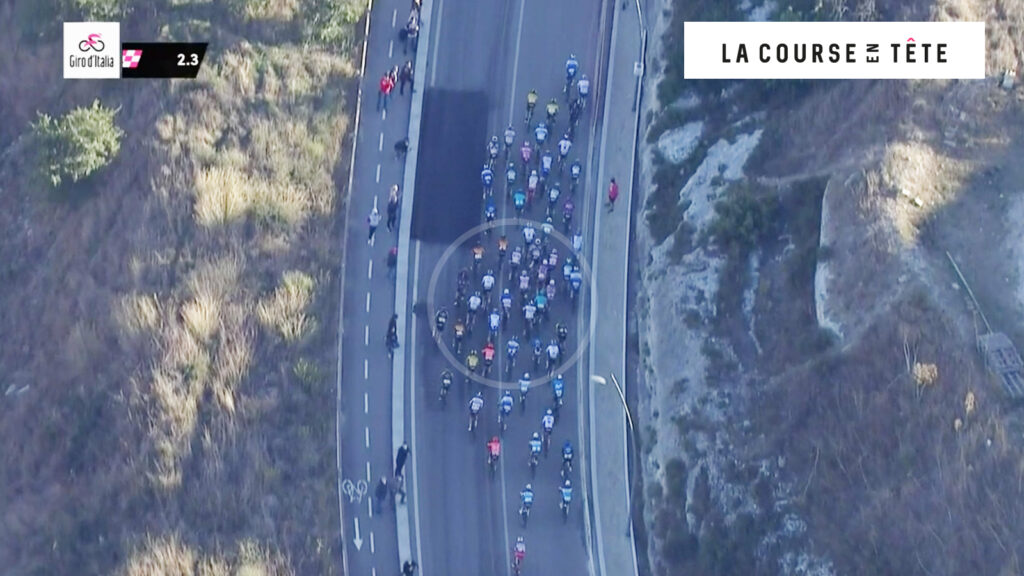
When it comes to route design, the run in to today’s finish was masterful. Instead of taking a more direct and flat route into the historic city, the loop around the northern part of Matera included a 750-metre climb (with a maximum gradient of 10%) that topped out just two kilometres from the line. It added an element of unpredictability to proceedings, moving the stage from guaranteed sprint finish territory into the tough-to-call category. “It was a very, very steep climb,” said Démare. “The race went hard on the climb. I lost a few places but I did not panic.”
The Groupama rider (circled) was well positioned going onto the hill but halfway up it the French champion was visibly dropping back. Runner-up in Tuesday’s sprint, Peter Sagan, is in a relative position of strength despite the complete absence of a traditional sprint lead-out train: the Slovak (positioned on the right-hand side, in the ciclamino jersey, passing the spectator) has team-mates Matteo Fabbro and Rafal Majka with him. Such is the unconventional nature of this finish that it provided us with the slightly unusual sight of GC contenders Vincenzo Nibali, Jakob Fuglsang, Steven Kruijswijk and Majka being visible towards the head of the peloton long after passing the three-kilometre to go mark.
One rider who wasn’t in contention for the victory in Matera today was Elia Viviani (Cofidis), who was dropped on the third-category Galleria Millotta climb some 26.5 kilometres out from the line.
1.4KM TO GO
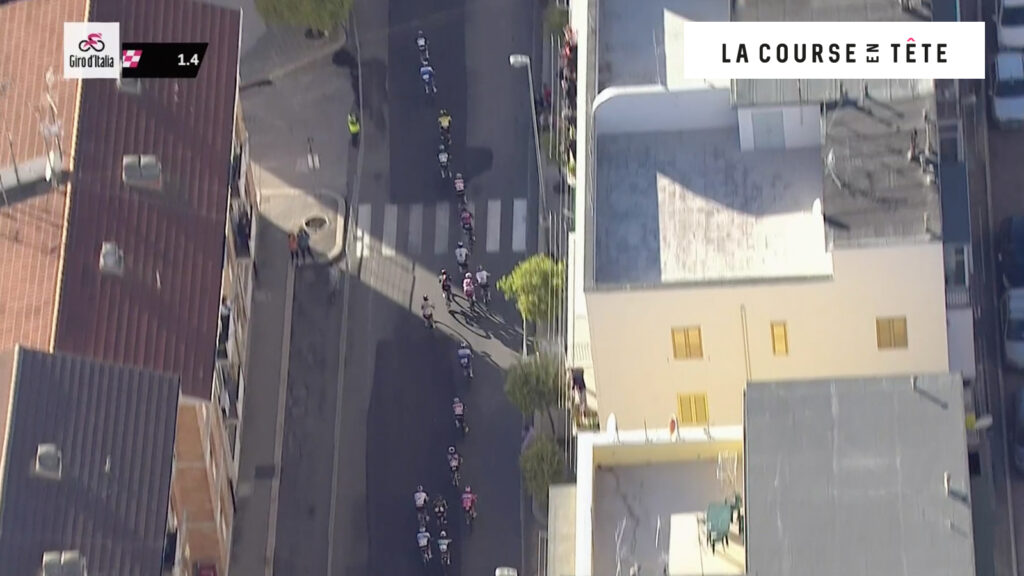
Not a single Groupama-FDJ rider can be seen at the head of the peloton as it headed down the Via Nazionale. The last sighting of Démare for nearly a kilometre came heading onto this straight; although the television pictures aren’t entirely clear, he appeared to be around 25 wheels back 1,600 metres from the line. “I didn’t get mad, I didn’t panic,” said Démare. “After the climb, [team-mate] Simon Guglielmi wanted me to go up to the front. I told him that I had to recover first.”
At the front is Fabbro, whose impressive 1.2-kilometre turn ends shortly after the flamme rouge. Sagan is being marked by Michael Matthews (Sunweb), who has team-mate and climber Sam Oomen with him. Deceuninck-Quick remain in a strong position: Dane Mikkel Frølich Honoré is following Fabbro, while Davide Ballerini (third in Villafranca Tirrena on Tuesday) is visible in the centre of the above still.
Although the climb into Matera didn’t generate any attacks, there was a – slightly surprising – move of note with 900 metres remaining from Vincenzo Nibali. The two-time Giro champion is not known for his sprinting, nor were Trek-Segafredo working for a fast finisher this afternoon. It appears that it was just a cautionary move by the Italian, given there was a 90-degree corner just 700 metres from the line, followed by a double apex bend onto the uphill finishing straight.
500M TO GO
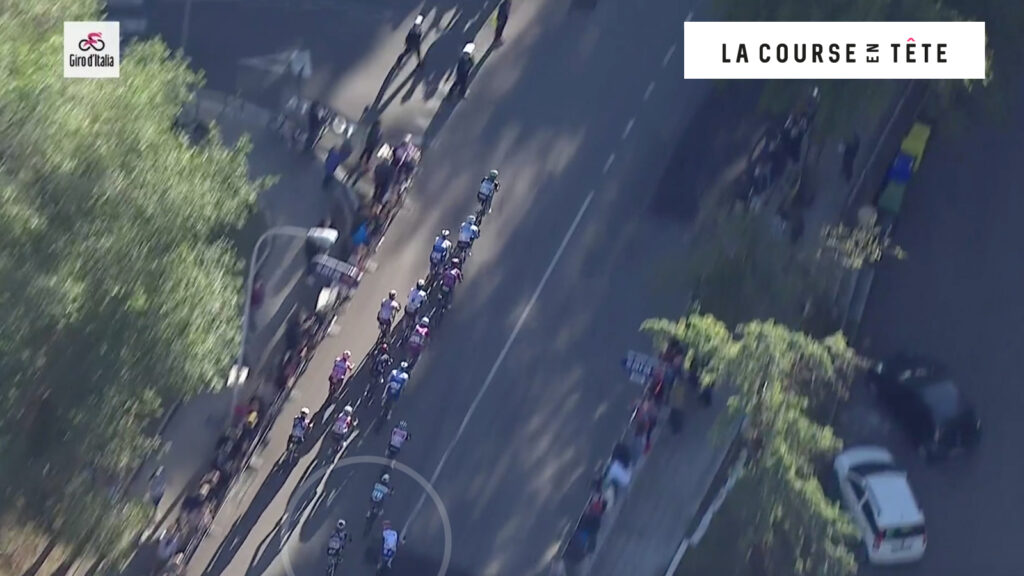
After Nibali’s short-lived acceleration, another GC contender – Majka – took over at the head of the peloton. With Davide Cimolai in the unenviable position of sitting his wheel a fair way out from the line, Matthews now flying solo, and Deceuninck’s inability to get organised, it still feels like advantage Sagan. Then again, we all thought that the Tour stages into Lavaur and Lyon were his to lose after BORA distanced his main sprint rivals long before both finish lines.
Circled at the bottom of the screen is Démare’s sole team-mate in vision at this point. However, it’s not his usual lead-out man, Jacopo Guarnieri, who was dropped on the climb. Deputising for Guarnieri today was Guglielmi, on his Grand Tour debut, who sits up after being unable to assist his team leader.
400M TO GO

No Guarnieri, no panic! Démare strikes lucky with 450 metres remaining, as he latches onto an abbreviated Astana train comprising Fuglsang and the team’s sprinter Fabio Felline on the right-hand side of the road. With a double apex left-hander leading onto the finishing straight, it’s a far from ideal line to take, but it’s Démare’s last hope. He said: “I was in the wheel of the Astana guy and I kept following. Once I’d done that, I didn’t brake!” The only other rider alert to Fuglsang’s move was AG2R-La Mondiale’s Andrea Vendrame, who also latched onto the train.
Navigation sorted, the Frenchman then benefits from a huge misjudgement from Majka. The Polish climber takes the first part of the final corner far too slowly, allowing Fuglsang to dislodge him at the head of the peloton on exit. Even though he’s off the racing line approaching the second part of the bend, Démare (circled) is already ahead of Matthews and nigh-on level with Sagan at this point. Crucially, neither Vendrame, who finished fourth on Tuesday, nor Felline are slowing his progress.
200M TO GO
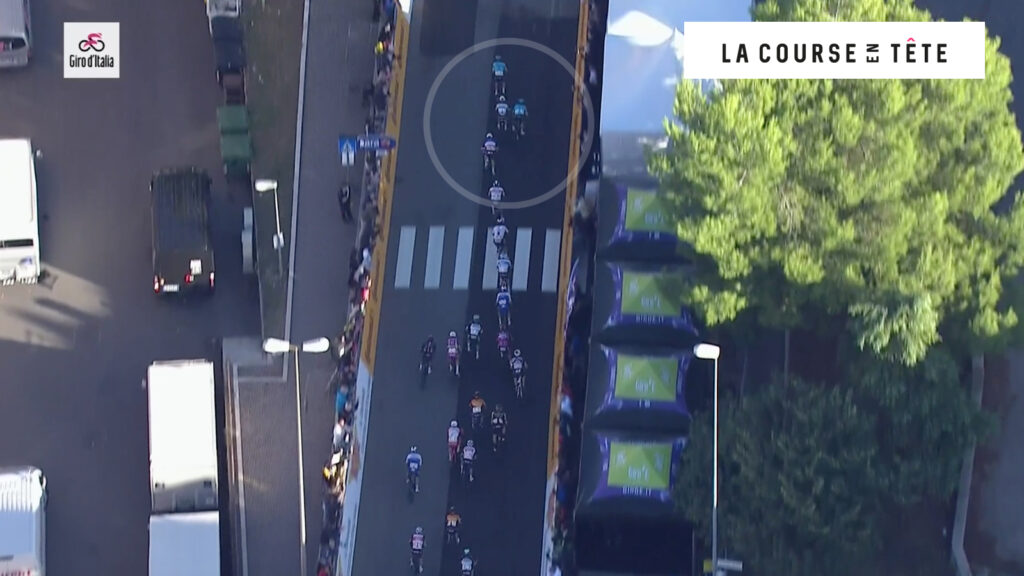
Majka is unable to recover from the lack of speed he took into the first part of the final corner, leaving Sagan, Matthews and everybody else who was in his wheel work to do. The comparison with Fuglsang’s lead-out is stark: the three riders immediately behind him at the head of the peloton as the race hits the finishing straight are Vendrame, Felline and Démare. Luckily for Majka, his team went easy on him, publicly at least, after the stage. “The squad then worked to bring Peter well positioned for the final climb but, unfortunately, after the last bend he wasn’t in a position to contend the sprint,” sports director Jan Valach said in their press release.
A bad situation turned into race over for Sagan as the peloton exited the final corner. Trying to salvage his chances, Cimolai moves out of Majka’s wheel turning into it in a last-ditch attempt to pick up speed. This only serves to box the Slovak in, something that he described post-race as an “unfavourable position.” Sagan loses any momentum he had leading onto the finishing straight and goes on to finish a distant eighth.
The above still shows Felline starting his sprint with 200 metres remaining on the right of the finishing straight. Having blinked first (and far too early given uphill drag to the line), Démare eventually responds to the Italian’s chosen path by moving in the opposite direction from him towards the centre of the road. Alert to how the race had swung in favour of those following Fuglsang, UAE-Team Emirates’ sprinter Juan Sebastián Molano and Matthews had quickly latched onto Démare’s wheel at the start of the straight then following the Frenchman when he picks his path to the line.
100M TO GO
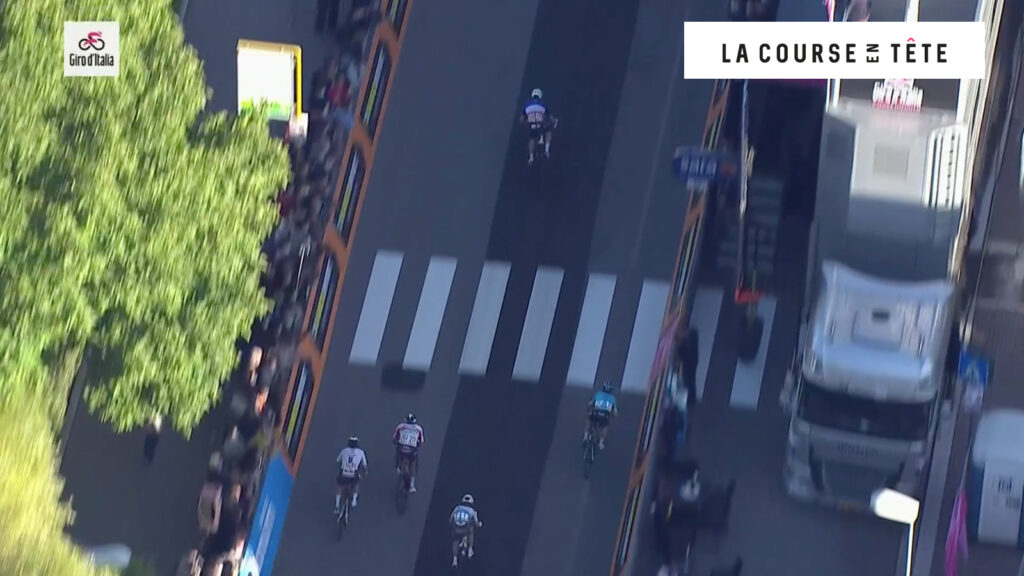
Given the position he was in with 500 metres remaining, it would have been remarkable enough to see Démare merely being in contention for the victory. But, having survived the climb into Matera and then being forced to tag-team the Astana lead-out train in desperation, he won the stage by a margin unlike any of his four previous Grand Tour victories.
Despite going long, Felline managed to take third, pipped in sight of the line by Matthews’ impressive kick. Had he not have been forced to make up ground exiting the final corner (he started the sprint from behind Molano, a wheel further back from Démare) the Australian may have come close to matching the Frenchman.
This win doesn’t just reinforce Démare’s status as the best sprinter since racing resumed at the end of the July. It finally puts him among the sprinting elite. For too long in big races it was a case of if he’d win, not when. Démare said he thought he’d lost out to Sagan and Ballerini at the end of Tuesday’s stage. In Matera on Thursday, there was no doubt who won. He was in a class of his own.
You can find more of Nick Bull’s race analysis on Twitter
Main photo: SWpix.com / Cor Vos

